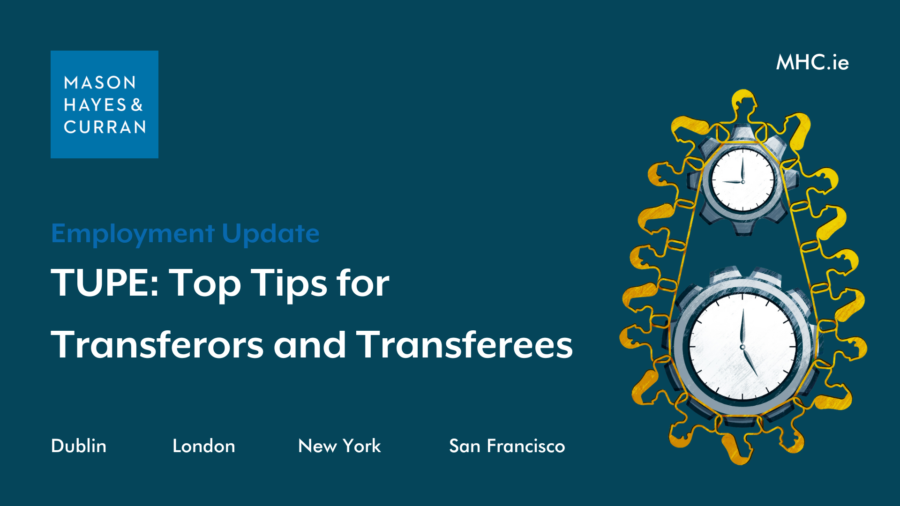TUPE: Top Tips for Transferors and Transferees

TUPE regulations impose strict responsibilities and obligations on both the transferor (outgoing employer) and the transferee (incoming employer). Our Employment Law & Benefits team reviews the key aspects of TUPE and shares practical tips to help employers stay compliant.
What you need to know
- The law governing the transfer of undertakings (TUPE) is complex and involves a number of obligations for both the transferor and transferee.
- Transferors and transferees must engage in a statutory information and consultation process with representatives of their respective affected employees.
- There is a legal obligation on the transferee to take on the existing employees of the business or part of the business transferred.
- When employees are transferred, a transferee inherits the associated liabilities and employment obligations of the transferor.
- Transfer-related dismissals are not permissible, subject to the ‘ETO Defence’.
Introduction
The transfer of undertakings as a process is governed by the European Communities (Protection of Employees on Transfer of Undertakings) Regulations 2003, also known as TUPE, or the TUPE Regulations.
Whether you are a transferor, ie the outgoing employer, or a transferee, ie the incoming employer, understanding your responsibilities and obligations under TUPE is essential to ensuring a smooth and successful transition. We provide some key tips to help you navigate the process.
Tips for the outgoing employer
1. Information sharing and consultation
Both the transferor and transferee must inform their respective employees affected by the transfer, via their representatives of the following:
- The date or proposed date of the transfer
- The reasons for the transfer
- The legal implications of the transfer for the employees and a summary of any relevant economic and social implications of the transfer for them, and
- Any measures envisaged regarding the employees
The transferor must provide this information at least 30 days before the transfer, where reasonably practicable, and in any event, in good time before the transfer occurs. If any measures or decisions concerning outgoing employees are envisaged, the transferor must consult employee representatives in advance, where reasonably practicable at least 30 days before the transfer, but always in good time. Early communication is recommended to facilitate agreement.
Where there are no employee representatives already in place, the employer must facilitate the appointment of representatives by the impacted employee population. This is usually done by way of election.
2. Handle redundancies carefully
The transfer of an undertaking, business, or part thereof, cannot be grounds for dismissal by the transferor. However, if redundancies are necessary for economic, technical or organisational (ETO) reasons, this is permitted under TUPE. This is frequently referred to as the ‘ETO Defence’. If a contract of employment is terminated because the transfer involves a substantial change in working conditions to the detriment of the employee concerned, it is the transferee / incoming employer concerned that is regarded as having been responsible for the termination.
3. Cooperate with the transferee on due diligence
The more detail provided by the transferring employer in advance of the transfer regarding employee service/tenure and terms and conditions of employment, the less likelihood of disputes.
Tips for the incoming employer
1. Understand and honour employees’ rights
When a transfer takes place, there is a legal obligation on the transferee to take on the existing employees of the business or part of the business transferred. The contractual rights of employees being transferred must be transferred intact. This means that the transferee will inherit and be responsible for honouring those terms and conditions which existed at the time of the transfer, including:
- Pay
- Holiday entitlement
- Collective agreements (if any), and
- Redundancy rights
Furthermore, in circumstances where employees retain their service on transfer, ensuring employee continuity of service is key.
Employee pension rights relating to old age, invalidity or survivors’ benefits under supplementary company or inter-company pension schemes do not transfer to the transferee. Similarly, non-contractual terms, such as policies and procedures which the transferor had in place before the transfer do not transfer to the transferee. An employer’s customs and practices may become implied terms of an employee’s contract over time. Therefore, it is vital that transferees obtain expert legal advice to understand incoming employee rights in order to ensure compliance.
2. Conduct thorough due diligence
The new incoming employer will also inherit existing disputes, claims or liabilities of the outgoing employer which are relevant to the incoming employees. It is vital to conduct thorough due diligence on the outgoing employer’s liabilities before a transfer process is commenced.
The corresponding legislation in the UK requires that transferors must provide the following information to transferees in advance of a relevant transfer. This can provide a good checklist for transferees in Ireland as to pertinent information to seek:
- Names and ages of transferring employees
- Particulars of employment
- Information on any grievances raised by employees in the previous two years
- Information on any disciplinary processes in the previous two years
- Any claims taken by employees against the transferor in the previous two years
- Any claims that the transferor has reasonable grounds to believe that an employee may bring against the transferee, arising out of the employee’s employment with the transferor
- Any collective agreement which will have effect after the transfer
3. Information sharing and consultation
The incoming employer has similar obligations to the transferor insofar as the information which must be provided to its employees that are affected by the transfer. This information must be provided to employees' representatives, where reasonably practicable, at least 30 days before the transfer. In any case, it should be shared in good time before the transfer directly affects employees' working conditions and terms of employment.
If the transferee plans any measures affecting its existing employees, it must consult their representatives, where reasonably practicable, at least 30 days before the transfer. As before, consultation should occur in good time before the transfer, aiming to reach an agreement. The Regulations provide guidance on information sharing and consultation when there are no existing employee representatives.
The creation of an effective onboarding strategy for transferring employees is crucial to ensuring better integration and mitigating unwanted risk.
4. Dismissal of transferred employees
Transfer-related dismissals are prohibited by the TUPE Regulations. This is subject to the ‘ETO Defence’. Transferees should evaluate whether business restructuring is necessary and ensure any changes comply with TUPE obligations. If changes are required for economic, technical or organisational reasons, proper procedures should be followed to mitigate legal risk.
Conclusion
TUPE can be a complex process with significant legal and practical implications for both transferors and transferees. Proper planning, effective communication, and strict adherence to legal obligations are key to a successful transfer. Seeking legal advice at an early stage can help ensure compliance and prevent potential disputes.
Contact our Employment Law & Benefits team to find out more.
The content of this article is provided for information purposes only and does not constitute legal or other advice.
Share this:




